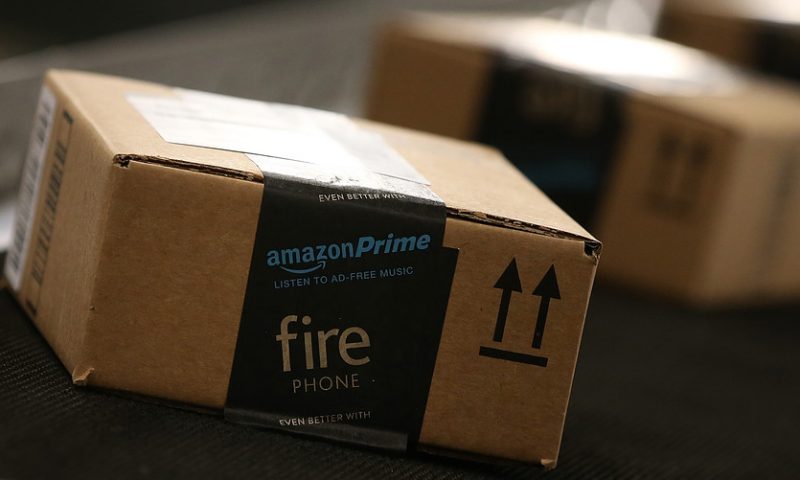Amazon shares have fallen more than 9% over the past three months
Amazon.com Inc. is scheduled to report third-quarter earnings after the closing bell on Thursday, and Bank of America Merrill Lynch says one-day shipping and a slowdown in the cloud services business could weigh on profit.
Analysts led by Justin Post say third-quarter Amazon Web Services growth decelerated, and costs to ramp up one-day shipping could increase.
“Increasing regulatory scrutiny, as well as AWS growth and margin concerns, have limited stock appreciation in 2019,” analysts said.
Amazon AMZN, -0.33% stock is up 18.5% for the year to date, while the S&P 500 index SPX, +0.24% has gained nearly 20%.
“We think the Street is constructive on the free one-day shipping benefit, but concerned on added investment to facilitate shipping and on the potential competitive impact on AWS growth,” analysts said. “Over time, we think Amazon should be able to better optimize shipping costs as more items are eligible for one-day delivery, a view that could help offset near-term concerns on one-day ramp up costs.”
Amazon committed $800 million in the second quarter to cut Prime delivery from two days to one and the company said during its earnings call that it’ll “see more cost in Q3.”
Bank of America rates Amazon shares buy with a price objective of $2,250, down from $2,350.
“We continue to have a positive view on potential for retail unit and revenue acceleration (easing comps over next three quarters plus benefit from Prime One Day), and improving setup for AWS growth in 2020,” analysts said.
Stifel analysts led by Scott Devitt think that the top line in North America will be bolstered by one-day shipping, but they’re keeping an eye out for lower operating income, due to the investment spending. Stifel forecasts operating income of $2.40 billion versus FactSet guidance for $2.94 billion, down from $3.72 billion last year.
“We support the company’s investment in faster shipping in an effort to widen the convenience advantage over e-commerce and traditional retail peers,” Stifel wrote.
“We would be buyers on any weakness stemming from potentially lower margin as historically the company has emerged from past investment cycles in a stronger competitive position and generated stronger-than-expected operating income dollars.”
Stifel rates Amazon stock buy with a $2,300 price target.
Amazon has an average buy rating, according to 48 analysts polled by FactSet. The average price target is $2,289.92.
Here’s what to look for in Amazon’s earnings:
Earnings: FactSet expects earnings per share of $4.59, down from $5.75 last year.
Estimize, which crowdsources estimates from sell-side and buy-side analysts, hedge-fund managers, executives, academics and others, expects per-share earnings of $4.92.
Amazon missed the FactSet earnings estimate in the last quarter, but beat expectations the previous seven quarters.
Revenue: FactSet is guiding for revenue of $68.82 billion, up from $56.58 billion last year.
Estimize has a forecast for $69.05 billion in revenue.
Amazon beat the FactSet revenue estimate the past three quarters.
Stock price: Amazon shares have fallen 9.2% over the last three months while the S&P 500 index is up about 1%.
Other items:
-Amazon could be taking share from grocery stores.
“The company’s Q2 results saw an uptick in purchases of convenience items and reports indicate that Amazon has eased restrictions and removed minimums on free shipping eligibility for low-priced CPG [consumer packaged goods] items such as toothpaste or floss, which should help the company take share of this category from grocery stores and pharmacies, resulting in increasing purchase frequency from Prime members,” wrote Canaccord Genuity in a note.
Canaccord rates Amazon stock buy with a $2,250 price target.
-Amazon expected to be among the retail leaders despite uncertainty. With the holiday shopping season kicking off, experts including the National Retail Federation have highlighted the uncertainty from global issues like tariffs, even as the forecasts call for sales growth.
The NRF forecasts sales growth of 3.8% to 4.2% this year, which would bring the total to between $727.9 billion and $730.7 billion.
“We continue to expect that increased consumer confidence, wage growth, low unemployment and the strong macroeconomic environment in the U.S. will result in 2019 retail sales growth of over 4%, led by e-commerce players like Amazon, off-price retailers like TJX and Ross, value and convenience-oriented retailers like Dollar General and Dollar Tree and discounters and warehouse clubs like Walmart and Target,” said Mickey Chadha, vice president at Moody’s.
Wells Fargo data published Sept. 9 showed that Amazon accounted for 30% of retail growth in the second quarter with U.S. gross merchandise volume of $45 billion, a 19% increase from the previous year.

